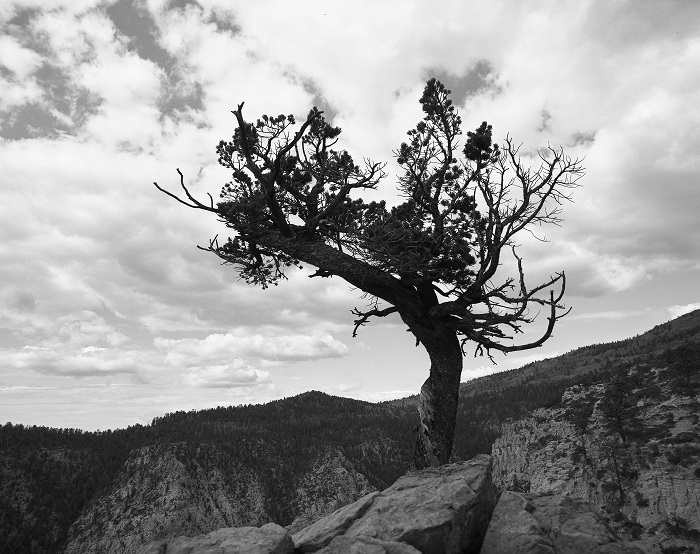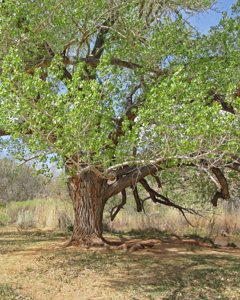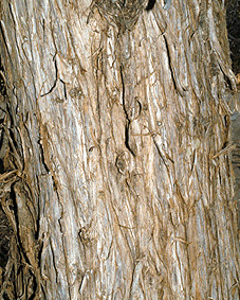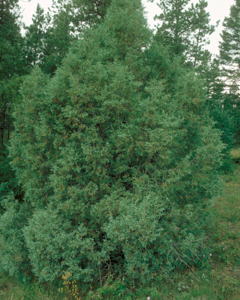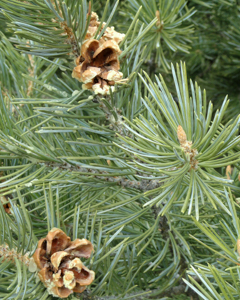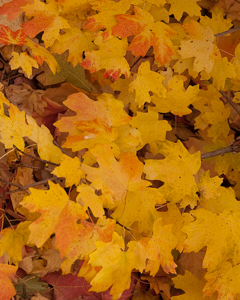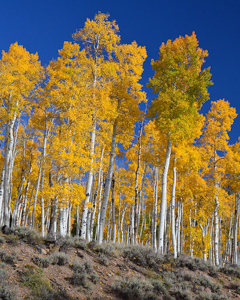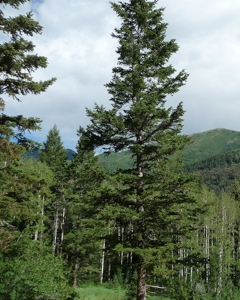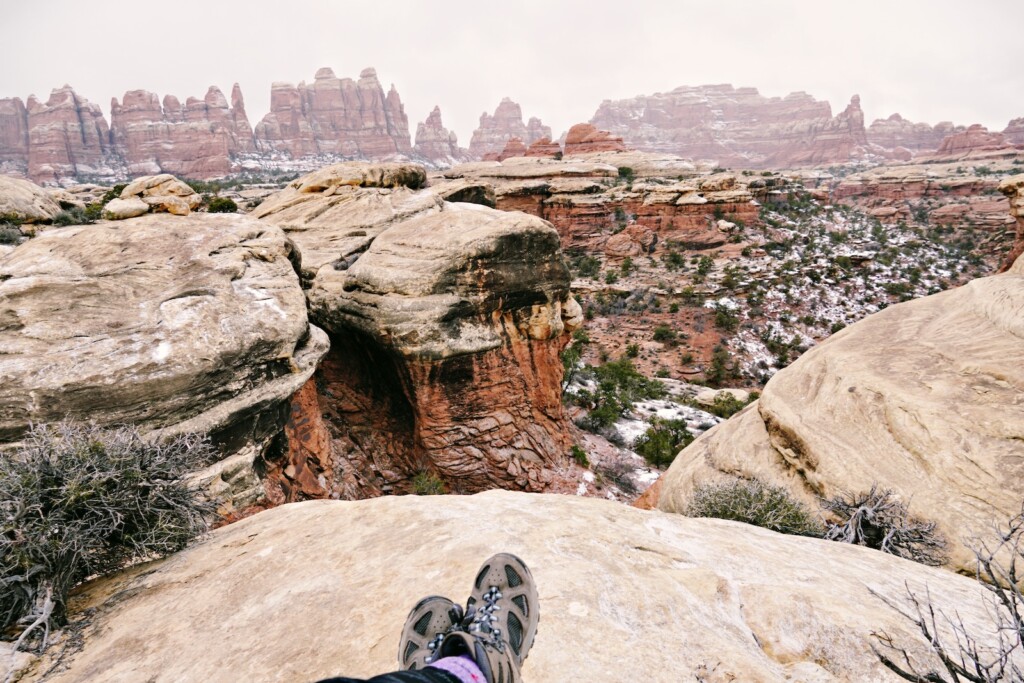While there are roughly 45* native tree species in Utah (an exact consensus cannot be found), this list highlights just seven, selected for their prevalence and curiosity and arranged according to elevation. Enhance your next outing by stopping to commune with them.
Listen for a moment. Take the leaves and limbs in your fingers, inspect them, ponder their design. You don’t have to become a certified dendrologist to do science, a poet to see beauty, or a shaman or seer to divine life.
Low Elevation (Desert)
Fremont Cottonwood (Populus fremontii)
A deciduous water-loving tree with broad crown and sweeping branches. Found predominantly in valleys and canyons along waterways, especially in southeastern part of the state along the Green, San Juan, and Colorado rivers and the tributaries that feed them. Grows at elevations of 2,000 to 6500 feet, lives 30 to 50 years on average, but can live as long 150 years.
Height: 40-80’
Diameter: 2-4’
Leaves: Broad, triangular leaves shaped like a rattlesnake’s head, about 3” long and
3” wide; coarse, irregular, rounded teeth on edges. Light green in spring and
summer, golden yellow in fall.
Bark: Light green and smooth on young trunks; thick, coarse, and gray with deep
ridges on older specimens.
Twigs: Light green, stout, hairless.
Flowers: Downy, pendulous catkins, about 3” long; sprout in early spring.
Fruit: Light brown, egg-shaped pods; contain several cottony seeds, carried by wind,
resemble flitting snowflakes in a stolid spring breeze.
Fun Facts: Named after American explorer, politician, and soldier John C. Fremont. Survival tip: Run out of water in the Utah desert? Look for a snaking line of cottonwoods on a valley floor, a solid indicator of water and shade.
Mid Elevation (Woodlands)
Utah Juniper (Juniperus osteosperma)
The most prevalent tree in Utah, found in virtually every region, and the primary species of Utah’s pygmy forests. A usually bushy evergreen, with rounded crown, forked trunk and spreading branches. Grows at elevations of 4,000 to 8,000 feet, lives on average 300 to 800
years, though the oldest in Utah is believed to be 1,275 years. Distinguishable from the Rocky Mountain juniper by its short twigs and shrub-like appearance.
Height: 15-40’
Diameter: 1-3’
Leaves: Scalelike, yellow-green needles that run opposite on twigs in four rows;
1mm thick, ¼” to ½” long.
Bark: Gray to rust-colored, fibrous, furrowed, shreddy.
Twigs: Stout, remain covered with overlapping leaves for years.
Fruit: Light blue, round cone, or “berry,” about the size of a No. 2 pencil eraser, 1/3”
in diameter, contains one seed.
Fun Facts: Often called cedar, and smells similar to Eastern red cedar wood that’s used for closets and trunks. Native Americans used the “berries” for food and the seeds therein for jewelry, sometimes called Navajo ghost beads.
Rocky Mountain Juniper (Juniperus scopulorum)
A graceful evergreen cypress with straight trunk, narrow, pointed crown and slender branches of aromatic green and drooping foliage; often symmetrical, branching from the ground up. Grows at elevations of 5,000 to 9,000 feet, found in mixed forests of Douglas fir and Gambel oak, ponderosa pine, pinyon, and Utah juniper, though more common in the Wasatch and Uinta ranges than in the desert regions.
Height: 20-50’
Diameter: 1 ½’
Leaves: Scalelike, green-gray, 1-2 mm long, of a lacey fineness; 1mm thick.
Bark: Rusty brown, thin, fibrous, furrowed, shreddy.
Twigs: Inconspicuous, as they remain covered with leaves for years.
Fruit: Light blue cones, or “berries,” with a whitish coat that can be wiped off;
usually contain two seeds.
Fun Fact: The oldest known living specimen is estimated to be over 3,200 years old and is located in Logan Canyon, Utah. Dubbed the Jardine Juniper, the ancient cypress can be accessed via the Jardine Juniper trail, a twelve-mile out-and-back route. It stands 44’ tall, with a diameter of 8’.
Pinyon Pine (Pinus edulis)
Small, bushy, resinous evergreen with a short, compact trunk and rounded spreading crown. Friend to the Utah juniper, and second to it in total surface area coverage across the state. Grows at elevations of 4,000 to 7,000 feet, living on average 400 to 500 years, but as
long as 1,000 years. Sometimes called the two-leaf pinyon, to distinguish it from the less common but similar single-leaf pinyon.
Height: 15-35’
Diameter: 1-2’
Leaves: Evergreen needles, two in a bundle, ¾” to 1 ½” long; light green.
Bark: Dark gray to reddish brown, rough, furrowed with scaly ridges.
Twigs: Slender, light gray, slightly coarse.
Fruit: 1 ½’ to 2’ long egg-shaped, yellow-brown cones; sticky with resin, contain
edible seeds.
Fun Facts: The edible seeds of the pinyon are the famous nuts often sold roadside in Utah, commonly called “pine nuts.” Native Americans have gathered and used the seeds for centuries. On good years over $1,000,000 are collected and sold on the commercial market. Pinyon is the number one source of nuts from uncultivated species in the United States.
Bigtooth Maple (Acer grandidentatum)
Also known as the canyon maple, the deciduous bigtooth is easily identified by the shape of its leaves (think Canadian flag). It is the greatest contributor to the palette of color that swathes Utah’s foothills and canyons in the early fall. Grows at elevations of 4,500 to 7,500 feet, predominantly in northern and central regions, often seen hanging out with Gambel oak and mountain mahogany.
Height: 20-50’
Diameter: 8-24”
Leaves: About 4” in diameter, splitting into three, sometimes five lobes that fan out and are
edged with several blunt teeth.
Bark: Thin with shallow furrows and grayish flat ridges.
Twigs: Round and reddish gray.
Flowers: Small, ¼” yellowish clusters that appear in early spring.
Fun Fact: The bigtooth maple is closely related to the sugar maple of the northeast and has been used as a source of sugar and syrup. But because one has to tap 160 gallons of sap to produce one gallon of syrup — compared to 40 gallons from the sugar maple — the practice
never flourished.
High Elevation (Alpine)
Quaking Aspen (Populus tremuloides)
A rapid growing deciduous tree with straight, clear limbs and high, rounded crowns. Cousin to the Fremont cottonwood, also of the poplar family. Grows at elevations of 6,000 to 10,000 feet, usually in thickets and stands interspersed with pines and firs. Easily
identifiable by its white bark and silvery green leaves that turn lemony yellow in the fall. Or, if not identifiable by sight, then by the shuttering sound it emits in a strange breeze. Also known as trembling aspen.
Height: 40-70’
Diameter: 1-1 ½’
Leaves: 1-3” long, nearly round, saw-toothed edge, quickly tapering to a point; shiny green
on top, dull green on bottom, turns golden yellow in autumn.
Bark: Whitish, smooth, thick, often marred with names of humans and numbers that relate
to their calendric system.
Twigs: Shiny greenish-white, slender, hairless.
Flowers: Slender catkins, 1-2” in length, appear in spring before the leaves.
Fun Fact: The largest living organism in the world, and one of (if not the) oldest, is a clonal colony of quaking aspens that share one root system, located in Fishlake National Forest, Utah. The organism, known as Pando, covers 106 acres, and is believed to be at least
80,000 years old.
Rocky Mountain Douglas-Fir (Pseudotsuga menziesii)
The Douglas-fir grows throughout Utah’s central mountain ranges, from north to south, and east into the Uintas and Book Cliffs. It can be found at elevations of 5,000 to 9,000 feet, usually in a belt above ponderosa pine and below Engelmann spruce and subalpine fir, and
sometimes betwixt blue spruce, limber and lodgepole pine. It is often seen peeking through and above aspen stands, presumably to get a clear view of Utah’s lovely landscape.
Height: 80-200’
Diameter: 2-5’
Leaves: Evergreen needles, spreading mostly in two rows, ¾” to 1 ¼” long, flattened with
rounded tips.
Bark: Reddish-brown, thick, deeply furrowed with broad ridges.
Twigs: Orangish-brown, slender, covered with short, silky hairs.
Fruit: Numerous small cones, orange-red in color, about 2 ½” long when mature, with
woody, strong cone scales.
Fun Facts: The Douglas-fir defied taxonomists’ efforts to categorize it. Because of its unusual cone, the tree has been, at times, a pine, a spruce, a hemlock, and a fir. In 1867 it was finally given its own genus — Pseudotsuga — which means false hemlock. The
hyphenated name is meant to indicate it’s not a true fir. It was at one time the greatest source of lumber in America, and remains a dominant source.
Conclusion
There’s an old proverb that suggests picking apart the flower will lead to greater appreciation of it. I have found this to be untrue. Having studied the science of trees I see them differently. I see them where I didn’t before. Hopefully this short introduction spurs you to the same. But it’s not enough to read. You’ve got to get out there and observe, and listen. Move around. Gently like.
*This excludes naturalized trees and treelike shrubs. If such are included, the list grows to the
hundreds.
Resources:
Utah State University Forestry Extension
Common Native Trees of Utah, Carl M. Johnson
Trees of Utah and the Intermountain West, Michael Kuhns
Field Guide to North American Trees Western Region, National Audubon Society

